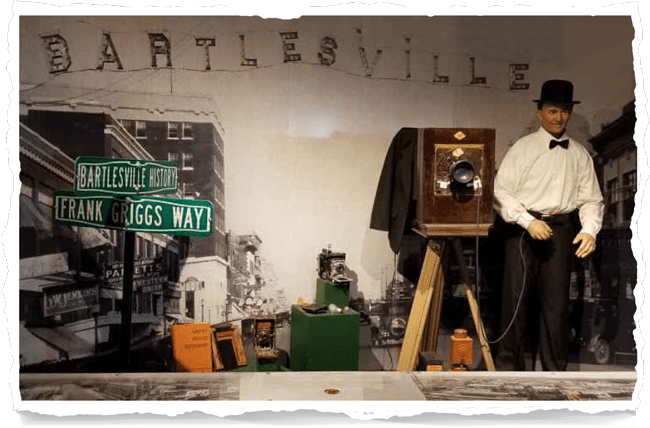Nelson F. Carr settles in the area and builds a trading post and sawmill on the Caney River.
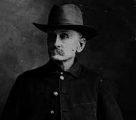
The History Museum is open Monday through Friday 8:00 a.m. to 4:00 p.m. | 401 S Johnstone - 5th Floor/City Hall


Nelson F. Carr settles in the area and builds a trading post and sawmill on the Caney River.
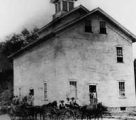
Carr cuts a millrace at the bend of the Caney River and builds a grist mill, powered by water, for grinding corn into cornmeal.
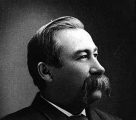
Jacob H. Bartles settles in the Silverlake area.
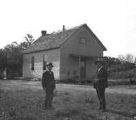
Bartles moves to Turkey Creek where he operates a trading post and the first post office. The Delaware Baptist Church and School, a subscription school, is built.
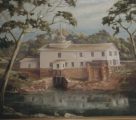
Jacob Bartles purchases the gristmill and blacksmith shop from Nelson F. Carr for $1000.
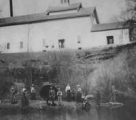
Bartles enlarges the mill and converts it to the grinding of wheat for flour.
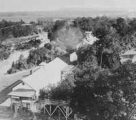
Bartles builds a store, with the family home on the second floor, north of the mill.
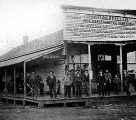
William Johnstone and George B. Keeler, both former clerks in Bartles’ store, establish a general merchandise store on the south side of the Caney River.
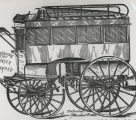
This is the Stage Coach that carried the mail from Coffeyville, Kansas to J. H. Bartles’ Store, Indian Territory in the early 70’s showing the Thayer Brake – patented March 11th, 1890. (See photo.) The first electric light system is established this year by Bartles on the north side of the Caney River.
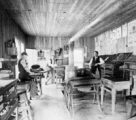
The first newspaper, the “Weekly Magnet,” is published every Friday.
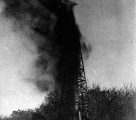
Bartlesville is incorporated as a city of the third class, with a population of 200, on January 15. The first commercial oil well in Oklahoma is discovered and the Nellie Johnstone No. 1 has its first gusher on March 25 and is completed on April 15. (See photo.)
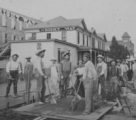
The National Hotel, later known as the Right Way Hotel, opens for business.
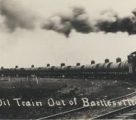
The Santa Fe railroad comes to Bartlesville. Bartles moves his combination store and home to establish the community of Dewey. Keeler builds the town’s first stone building at the northwest corner of Second Street and Johnstone Avenue.
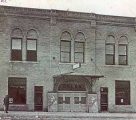
The Oklah Theater is built.
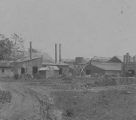
The Vitrified Brick Plant opens for business, producing 50,000 bricks a day. One of the town’s earliest industries, Crystal Ice and Storage Company, is built.
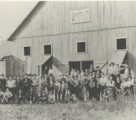
The Great Western Glass Company is established.
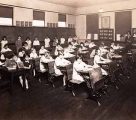
Garfield School is erected. The Almeda Hotel opens for business at the corner of Second Street and Johnstone Avenue. On January 31, the City Fire Department makes its’ first run.
December 8, 1905, Town of Dewey Incorporated (Per OHS – Dewey was founded in 1899 by Jacob H. Bartles and was named in honor of Spanish-American War hero Adm. George Dewey. The Dewey post office was established on April 19, 1899, and the town was incorporated six years later.
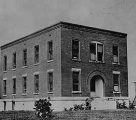
A 15 bed hospital is built. (See photo.) The Lanyon-Starr smelter is built. The Phillips brothers incorporate the Lewcinda Oil Company.
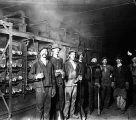
Bartlesville Zinc Company and National Zinc Company are constructed. (See photo.) Indian Territory and Oklahoma Territory are joined as the state of Oklahoma. On December 12, Governor Haskell proclaims Bartlesville “a city of the First Class.” The city is comprised of 85 blocks with some 850 lots and 4,215 residents.
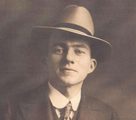
Frank Griggs, photographer, arrives in Bartlesville. (See photo.) Seven black students attend the newly established Douglass School. The Interurban street cars begin running loops.
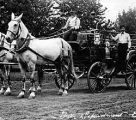
The City Hall and Fire Department is built at the northwest corner of Fourth and Dewey Streets. The first Bartlesville High School is completed.
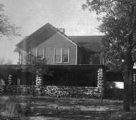
Bartlesville Country Club (later known as Oak Hill Country Club) is organized.
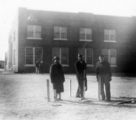
Another addition to the Douglass School building is added. St. John Catholic School is established. The first Boy Scout troop is organized.
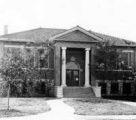
Bartlesville’s first public library opens with approximately 300 books.
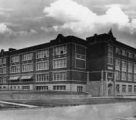
Bartlesville becomes the first town in the state to establish a junior high school.
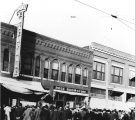
Fans wait in front of 120 3rd street for the score of the sixth and final game of the World Series played on October 15, 1917. Chicago vs. New York. Chicago won the game 4-2 and the series 4-2. (See photo.) Phillips Petroleum Company is incorporated with 27 employees.
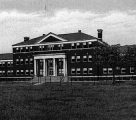
The Bureau of Mines is established.
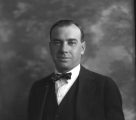
H. C. Price opens a small electric welding shop which becomes the H. C. Price Company.
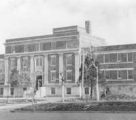
Memorial Hospital opens. The American Legion baseball team is formed.
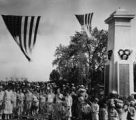
On May 24, the Seventh Street Bridge is dedicated to the men and women of Washington County who served in World War I.
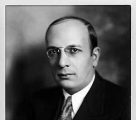
Armais Arutunoff, inventor of the submergible electrical pump and motor, moves to Bartlesville (see photo.) Frank Phillips builds his ranch, Woolaroc. The Civic Center opens on Johnstone Avenue between 6th and 7th Streets. The Caney River crests at 26 feet above normal level.
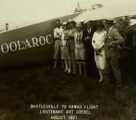
The “Woolaroc” airplane, piloted by Art Goebel and fueled with a new Phillips gasoline, wins the Dole San Francisco-to-Honolulu race.
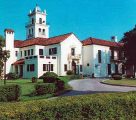
H. V. Foster, president of the Indian Territory Illuminating Oil Company, builds his town home, “La Quinta.”
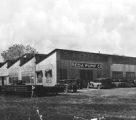
REDA Pump is organized by Arutunoff. (See photo.) The first Garden Club is established.
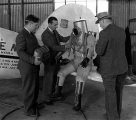
Wiley Post, wearing the first space suit, makes the first stratospheric flight. There are 64 days above 100 degrees and 25 consecutive days above 100 degrees. On August 14th, Bartlesville is the hottest spot in the nation at 107 degrees.
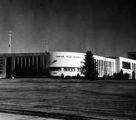
The Senior High School and Junior College, commonly called “Col-Hi,” is dedicated.
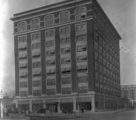
Cities Service Company becomes a major oil company with the purchase of I.T.I.O. for $70 million.
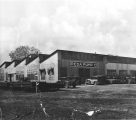
REDA employees make aircraft parts under World War II defense contracts. H. C. Price Company foremen and welders work in shipyards building Liberty ships, tankers and LST’s.
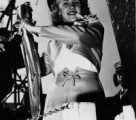
The S. S. Bartlesville Victory ship is christened.
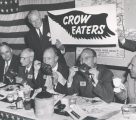
Hulah Dam Celebration — Senator Kerr looks on at the Crow Eaters banquet, May 3, 1946. The Welty family eat crow after the money was appropriated by the government for Hulah Dam. (See photo.) Hilltop Drive-In opens on Nowata Road, “three miles east of Bartlesville.” Murphy’s Original Steak House opens on West Third Street.
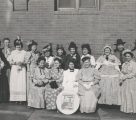
The city celebrates 50 years of existence with a parade and commemorative currency.
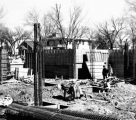
Phillips Hotel-Apartments construction begins. (See photo.) YMCA wins the Swimming Championship. The Westside Community Center Association is founded.
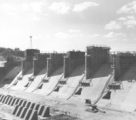
The Hulah Dam is completed. (See photo.) Phillips Petroleum Company scientists invent polyethylene, which becomes one of the most widely used plastics in the world.
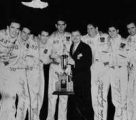
The Phillips 66er’s basketball team wins the first of two Olympic trials championships in New York (see photo). Third Street is renamed Frank Phillips Boulevard. Jane Phillips hospital is dedicated.
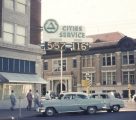
Oklahoma recorded weather shows July statewide and hottest July of the century. 1954 was warmest year of the century statewide. On July 14, 1954 the temperature, recorded at 116 degrees at 5:57 p.m. on the Cities Service sign. (See photo.) Phillips Petroleum Company develops and introduces the industry’s first all-season motor oil.
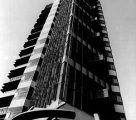
The Price Tower designed by Frank Lloyd Wright is completed.
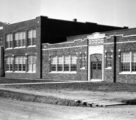
Douglass School goes from 12 to 8 grades as integration of the school system begins.
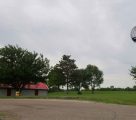
Work begins on Sooner Park and Adams Municipal Golf Course.
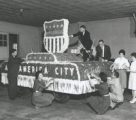
Bartlesville is named the “All America City.”
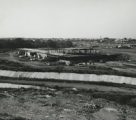
Eastland Shopping Mall is constructed.
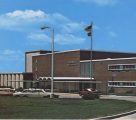
Sooner High School holds its first classes. Bartlesville is the only city in Oklahoma to endorse Daylight Savings Time.
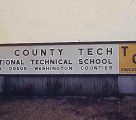
Tri-County Vocational Technical School opens. (See photo.) Cities Service announces plans to move its operations and 900 employees to Tulsa.
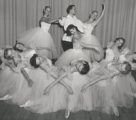
The Bartlesville Civic Ballet gives its first performance.
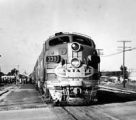
The last passenger train leaves Bartlesville. Douglass School closes.

Bartlesville completes its United States Bicentennial project with the opening of Pathfinder Parkway.
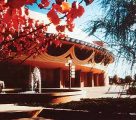
The ultra-modern Bartlesville Community Center opens.
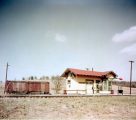
After the Hulah Dam was built the town of Hulah was displaced, and cattle and oil shipping fell off, so Santa Fe closed the feeder line to Hulah. The land and depot reverted to the Mullendores, descendants of the Brown-Buckboren family. In October 1983, Mrs. Kathleen Mullendore gave the depot to the Landmark Preservation Council of Bartlesville and the Council moved the depot to Johnstone Park.

Washington Park Mall opens. (See photo.) In December, T. Boone Pickens makes a hostile takeover attempt on Phillips Petroleum Company.
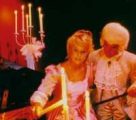
The premiere season for the OK Mozart International Festival.
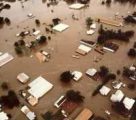
The Caney River crests at a record high of 29 feet above normal on October 4.
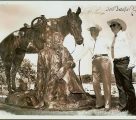
Phil Phillips and artist Joe Beeler standing beside heroic statue of “Thanks for the Rain” at Woolaroc at the dedication of the sculpture in 1987. The photo is autographed by both men. (See photo.) Indian summer begins as an annual celebration of the city’s Native American heritage.
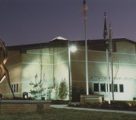
The new Bartlesville Public Library and History Museum dedicated. (See photo.)The first annual SunFest festival takes place at Sooner Park. Alta Photographic, Inc. (also produces Kalioka bottled water) joins Bartlesville’s industrial park.
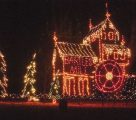
The First Fantasy Land Forest lights up Johnstone Park.
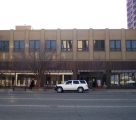
I.T.I.O., once one of the most prominent oil companies in Bartlesville, returns as a downtown shopping mall.
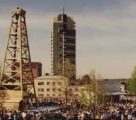
A hundred years in the making, Bartlesville celebrates its’ Centennial!
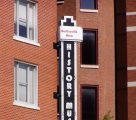
2000 — A citywide bond issue in 1998 paved the way for the municipal offices to move to a refurbished five-story office building in downtown Bartlesville, with the top floor set aside for a completely new history museum. The 10,000-square foot, first-class facility, opened in November 2000.
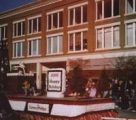
Conoco and Phillips merge to form ConocoPhillips
Through photographs, artifacts and video, Bartlesville’s heritage unfolds with stories of Indian chiefs, ranchers, bankers, outlaws, oilmen, schoolteachers, smelter workers, shop clerks and many others who helped to shape a tiny frontier settlement into a modern city.
That history unfolds for visitors to the museum with interactive displays, exceptional photography and intriguing artifacts. One of the museum’s most popular attractions is a talking animated likeness of Frank Griggs, pioneer photographer who spent seven decades documenting Bartlesville life.
